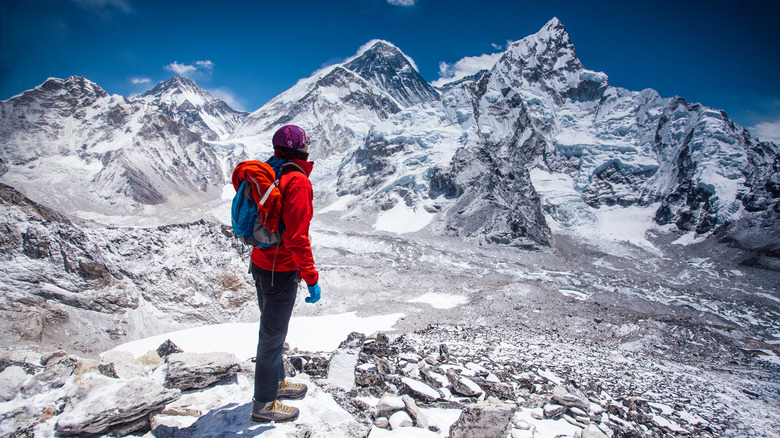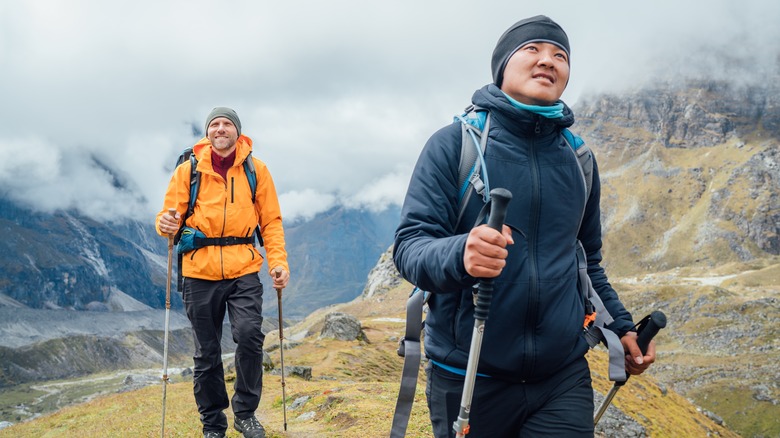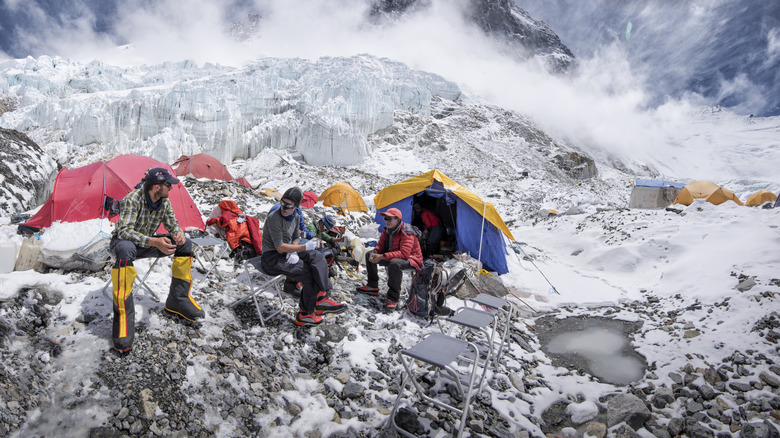The Price To Climb Mount Everest Is Higher Than You Think
A true test of the human body and mind, climbing Mount Everest is on many an adventurer's bucket list as the ultimate challenge of endurance. Known as one of the most difficult mountains to climb in the world, the legend of Mount Everest stretches far beyond mountaineering to include stories of triumph and survival that continue to draw climbers from across the globe. All of this so they can officially join a relatively exclusive club of just 6,664 other people who have succeeded in their quest to reach the top (at the time of this writing).
However, beyond the physical training and mental prep necessary to actually make it all the way up to the summit, there's one more important detail that Everest hopefuls should take into account: Climbing Mount Everest can get pretty darn expensive — and venture well into quadruple-digit territory. From booking flights to buying gear and securing the necessary permits and cleaning fees (which partly go to combating the unsettling poop problem at the summit) the costs of climbing Everest can quickly add up — ultimately hitting you with a hefty price tag that'll knock your breath out even more than the climb itself.
Climbing Mount Everest can cost upwards of $60,000
According to recent data from the team at ExpedReview, climbers planning to tackle Everest in 2024 can expect to spend anywhere between $33,000 and $200,000 — with the average trip sitting around $59,000. That said, the massive disparity in prices typically depends on four major financial components: guide services, travel expenses, permits and insurance, and essential supplies.
For starters, most local Nepali companies will typically charge around $39,500 for all-inclusive guided expeditions — which means you won't have to deal with any of the paperwork. Alternatively, there's also the option of booking with a Western tour company — which can set you back around $48,000 for a Sherpa-guided expedition, or anywhere up to $65,000 for a premium experience that's led by a Western guide. Along with an experienced guide, most of these all-inclusive options generally take into account other costs, except for any personal gear (though, many include group gear for camping and climbing).
Along with choosing the right guide for your expedition, there are plenty of other must-haves that can quickly start to add up before you've even made it to Nepal. These include a Nepali visa ($125), as well as a series of recommended vaccinations — specifically tetanus, typhoid, and cholera — that can set you back around $200. Throw in flights to Kathmandu from the U.S. — which can cost at least $1,200 — as well as transportation to Lukla — where most Everest treks begin — for around $300 to $500, and you're looking at some hefty bills before even lacing up your hiking boots.
Other costs to keep in mind when hiking Mount Everest
Unfortunately for climbers, the spending don't stop there. Running upwards of $20,000, other added expenses include a climbing permit ($11,000), an organization fee ($2,500), a non-refundable trash deposit ($4,000), and payment to a liaison officer ($3,000). From there, mandatory insurance also varies significantly price-wise, and can come up anywhere between $70 to $5,000.
Once all the paperwork and administrative fees are said and done, there are also the supplies and equipment to think about. Per ExpedReview's breakdown, you'll want to budget around $6,000 for food and a personal cook during a six-week trek — although some travelers cut down on this fee by not hiring a cook and simply doing it themselves. Along with that, supplemental oxygen is also vital. Cost-wise, the recommended five bottles — plus a mask and regulator — can set you back roughly $4,000 total.
Lastly, there's the issue with finding the right gear for an Everest expedition. And while trying to cut back on spending and buying hiking gear on a budget might do just fine for other adventures, Mount Everest isn't your average hiking trail. From boots, gloves, and insulated clothing to more specialized trekking items like crampons, poles, ice axes, and a harness — as well as campsite necessities like a heavy-duty sleeping bag and foam pad — most Everest hopefuls should expect to spend upwards of $7,000 on their new mountain-safe gear.


